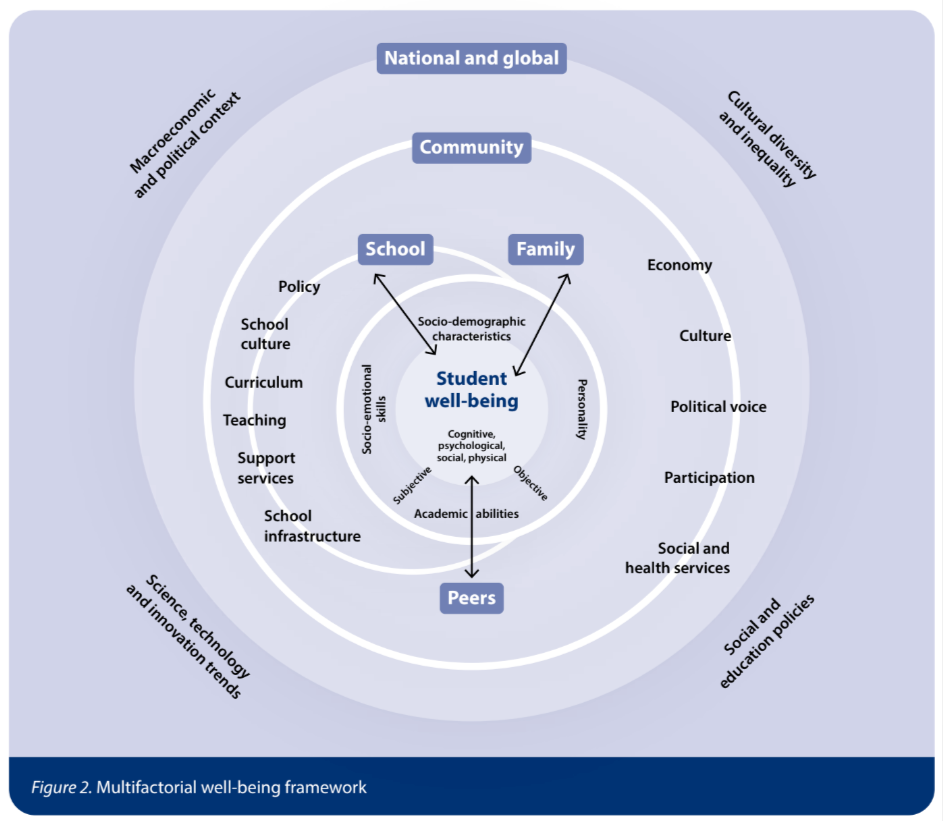
Well-Being in Schools: Understanding the Complexity of Well-Being in Schools
A focus on subjective well-being and school life satisfaction is practical, measurable, and comprehensive and gives schools an opportunity to make a difference in the lives of young people.
– International Baccalaureate Organization

INTRO
The International Baccalaureate (IB) suggests that a well-being policy is one of the most effective means for improving students’ attainment outcomes. The current paper is meant to support IB teachers and school leaders in better understanding and integrating well-being into the architecture of their school policy and practice as part of successful implementation of IB programs.
This paper is the first policy research paper in a series on student well-being in IB World Schools. Before you begin building an approach to well-being in your own school, it’s important to understand well-being in a school context. This resource details a well-known model that maps influencers of student well-being at the micro, meso, and macro levels.
OBJECTIVES
- Understand the complexity of well-being in a school context
WELL-BEING IN A SCHOOL CONTEXT IS COMPLEX
A well-known model in mapping the social influencers of students is the ecological one (Bronfenbrenner 1992). According to this model, there are three main levels of influencers for student well-being.
- Micro-level influencers—family, peers, teachers, school and proximal natural environment
- Meso-level influencers—community culture, participation in, and access to, various services and opportunities
- Macro-level influencers—national and global factors that indirectly influence overall student well-being

Micro-level influencers
Family and peers are the closest and the most influential factors of student well-being.
Research has shown that when family and peers are supportive, students are less likely to develop stress or anxiety. Socializing with friends outside of school is positively associated with life satisfaction, and adolescents who have higher-quality social networks also have better health and overall well-being (OECD 2017).
School, classroom, and teaching factors are also highly influential.
On average, across OECD countries, students who reported that their teacher provides support and is interested in their learning are about 1.3 times more likely to feel that they belong at school. Happier students tend to report positive relations with their teachers, and students in “happy” schools report much higher levels of support from their teacher than students in “unhappy” schools. Teachers modeling well-being behaviors, teaching competences, positively engaging students within the classroom, and school climate are all important predictors of student well-being.
Natural and physical learning environments also greatly influence student well-being.
According to a recent study, well-designed classrooms can boost learning progress in primary school students by up to 16% in a single year (Barrett et al. 2015). Among the most influential factors are light, temperature and air quality. According to the study, almost a third of the learning achievements are due to individualization of the learning environment (ownership and flexibility) and 23% are due to the level of stimulation (complexity and color).
MESO-level influencers
The community acts as a mediator between a student’s well-being in school and the broader social and economic landscape.
The participation of students in the life of the community through service learning and engagement has a significant impact on students’ sense of belonging in the community.
MACRO-level influencers
National and global factors are also found to indirectly influence overall student well-being.
National education policies, as well as global trends, are shaping the way we understand the role of well-being in facing present and future challenges for young people. These include, but are not limited to: the exponential growth of knowledge and data that are digitally available, social-media engagement, the volatile prospects of employment and adult life in a fast-changing world, social and political conflicts, and concerns around the sustainability of our planet.
REFLECTION
- For each of the three levels of influence, identify 3-5 factors that you think/know have the most impact on your community’s students











Responses